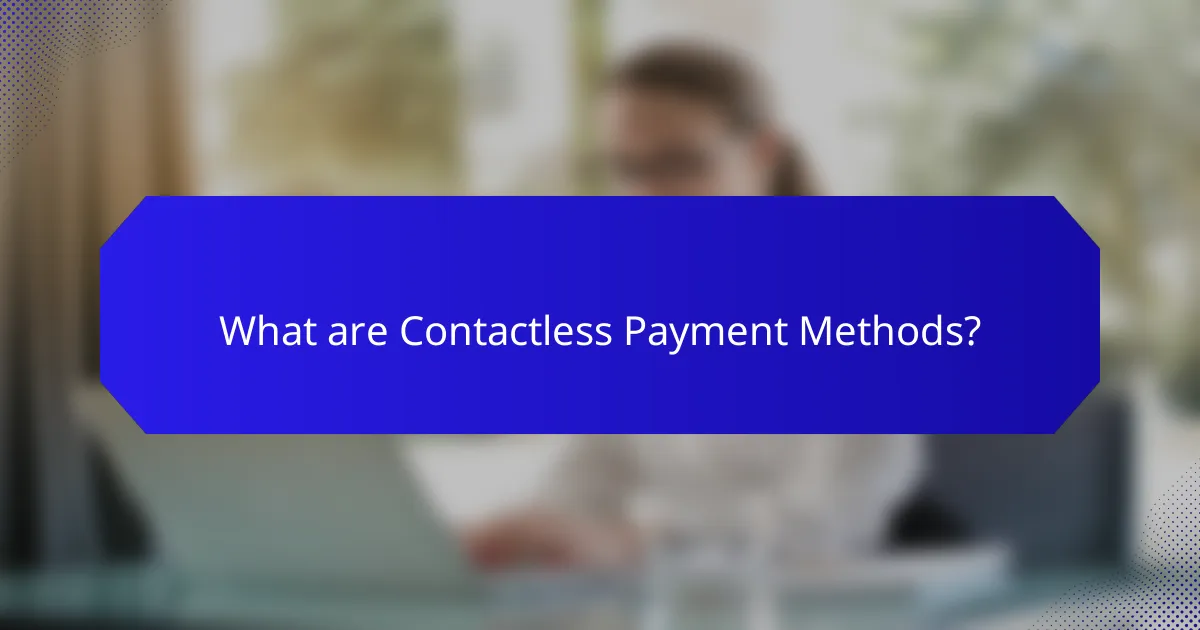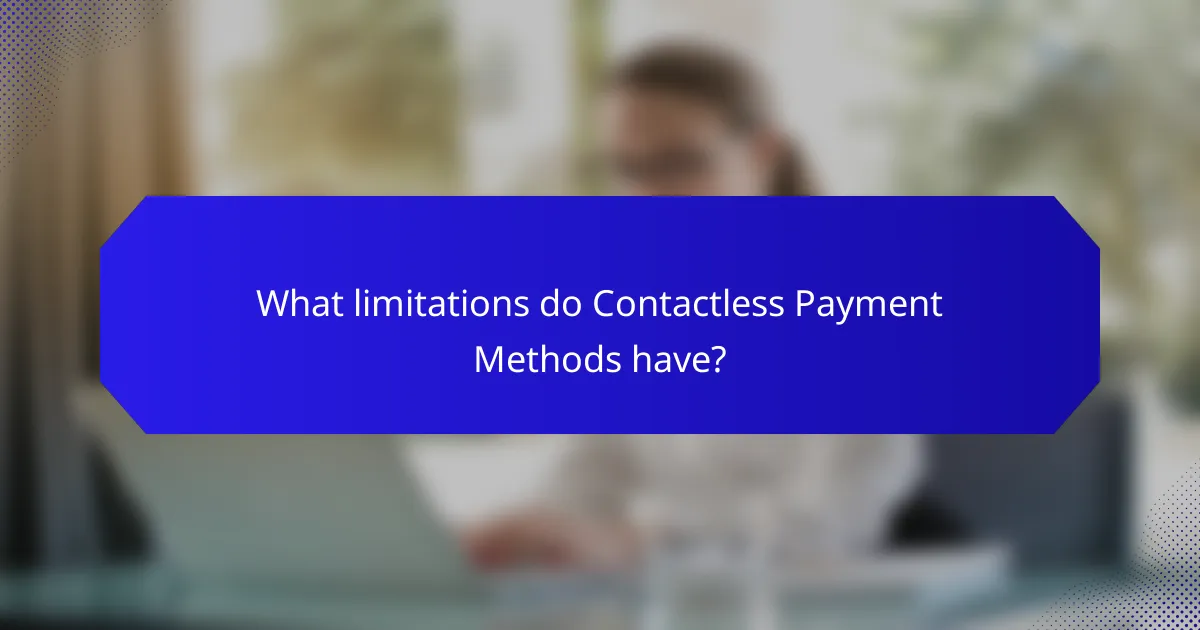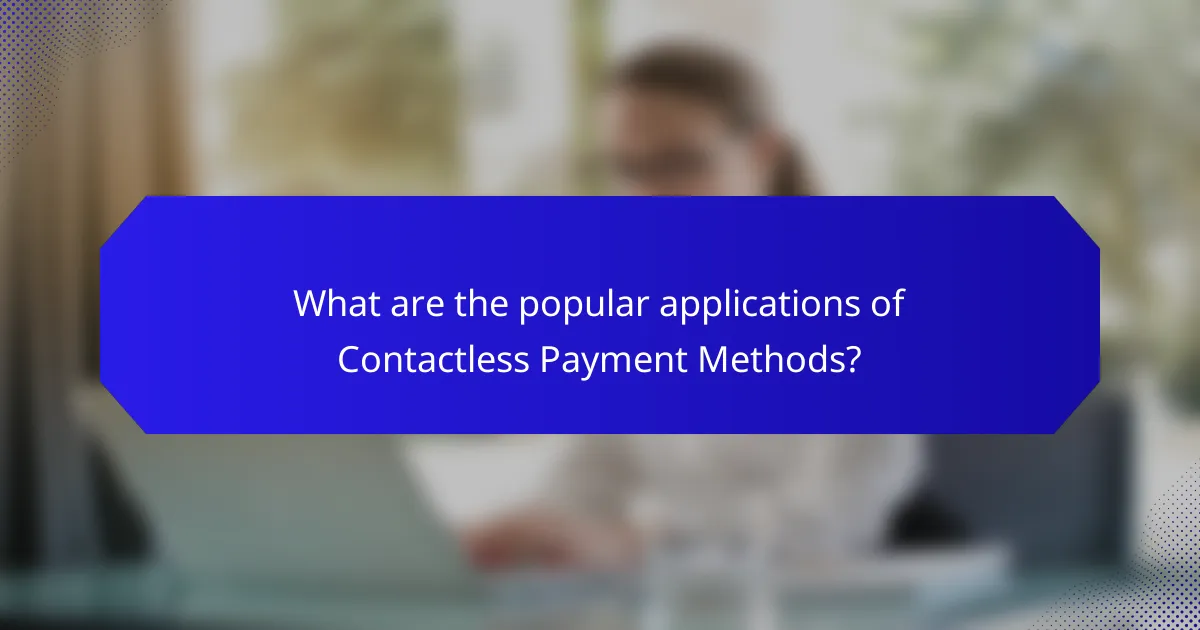Contactless payment methods enable users to conduct transactions without physical contact, utilizing technologies such as Near Field Communication (NFC) and Radio Frequency Identification (RFID). These payment systems offer speed and convenience, with over 30% of card transactions in the U.S. being contactless as of 2021. However, limitations include transaction caps, compatibility issues, and security concerns. Popular applications encompass retail transactions, public transportation, and mobile payment solutions like Apple Pay and Google Pay. The contactless payment market is expected to see significant growth as adoption increases across various sectors.

What are Contactless Payment Methods?
Contactless payment methods are transactions that allow users to make payments without physical contact. These methods typically use technologies like Near Field Communication (NFC) or Radio Frequency Identification (RFID). Users can complete transactions by simply tapping their card or mobile device near a compatible terminal. This process is fast and convenient, reducing the time spent at checkout. According to a 2021 report by the Nilson Report, contactless payments accounted for over 30% of all card transactions in the U.S. This growth reflects the increasing consumer preference for quick, secure payment options.
How do Contactless Payment Methods work?
Contactless payment methods work by using near-field communication (NFC) technology. This allows devices, such as smartphones or contactless cards, to communicate wirelessly with payment terminals. When a user taps their device near the terminal, the NFC chip transmits payment information securely. The transaction is completed in seconds, enhancing convenience for users. Security features, like encryption and tokenization, protect sensitive data during the transaction. According to a report by the Nilson Report, contactless payments are projected to reach $6 trillion globally by 2024, indicating their growing acceptance.
What technologies enable Contactless Payment Methods?
Contactless payment methods are enabled by technologies such as Near Field Communication (NFC) and Radio Frequency Identification (RFID). NFC allows devices to communicate wirelessly over short distances, typically within a few centimeters. RFID uses electromagnetic fields to transfer data between a reader and a tag. Both technologies facilitate quick and secure transactions without physical contact.
Smartphones, smartwatches, and contactless cards commonly utilize these technologies. NFC is widely used in mobile payment applications like Apple Pay and Google Pay. RFID is often found in transit cards and loyalty programs.
According to a report by Statista, the global contactless payment market is projected to grow significantly, indicating increasing adoption of these technologies. This growth underscores the importance of NFC and RFID in modern financial transactions.
How is data transmitted in Contactless Payment Methods?
Data is transmitted in contactless payment methods using Near Field Communication (NFC) technology. NFC allows devices to communicate wirelessly when they are within a few centimeters of each other. When a user taps their payment card or mobile device on a terminal, the NFC chip in the device sends encrypted transaction data to the terminal. This data includes the account number and transaction amount. The transmission occurs in milliseconds, ensuring quick and efficient processing. The use of encryption helps secure the data during transmission. According to research by the Smart Payment Association, NFC technology is widely adopted for secure contactless transactions globally.
What are the key benefits of Contactless Payment Methods?
Contactless payment methods offer several key benefits. They provide convenience by allowing quick transactions without the need for cash or physical cards. Users can complete payments by simply tapping their device near a reader. This speeds up the checkout process, reducing wait times for consumers and merchants alike. Security is enhanced as these methods often use encryption and tokenization to protect sensitive information. According to a study by the Federal Reserve, contactless payments have increased in usage, reflecting consumer preference for faster, safer transactions. Additionally, contactless payments promote hygiene by minimizing physical contact with payment terminals.
How do Contactless Payment Methods enhance convenience for users?
Contactless payment methods enhance convenience for users by allowing quick transactions without physical contact. Users can simply tap their card or device near a reader to complete a purchase. This process reduces the time spent at checkout, making it faster than traditional methods. Studies show that contactless payments can decrease transaction time by up to 50%. Additionally, these methods minimize the need for cash handling, which streamlines the payment process. Users also enjoy the added benefit of not needing to enter a PIN for small purchases, further speeding up transactions. Overall, contactless payments significantly improve user experience through efficiency and ease of use.
What security features are associated with Contactless Payment Methods?
Contactless payment methods incorporate several security features to protect user information. These include encryption, which secures data during transmission. Tokenization replaces sensitive card information with a unique identifier. This ensures that actual card details are not shared with merchants. Additionally, contactless payments often require user authentication, such as a PIN or biometric verification. This adds an extra layer of security against unauthorized transactions. Many systems also use near-field communication (NFC) technology, which limits the range of communication to a few centimeters. This reduces the risk of interception by unauthorized devices. According to a study by the Federal Reserve, contactless payments have seen increased adoption due to their secure nature.
How do Contactless Payment Methods speed up transactions?
Contactless payment methods speed up transactions by enabling quick and seamless transactions without the need for physical contact. These methods utilize RFID or NFC technology to allow users to simply tap their payment cards or mobile devices on a reader. This process reduces the time spent on entering PINs or signing receipts. Studies show that contactless payments can reduce transaction times by up to 50%. Additionally, the convenience of not having to handle cash or cards speeds up the checkout process. Retailers also benefit from faster transactions, leading to increased customer satisfaction and potentially higher sales.

What limitations do Contactless Payment Methods have?
Contactless payment methods have several limitations. One major limitation is the transaction limit, which restricts the amount that can be spent in a single transaction. For example, many systems cap transactions at $50 or $100. This can be inconvenient for larger purchases.
Another limitation is the need for compatible technology. Not all merchants support contactless payments, which can limit usability. Additionally, security concerns exist. Although contactless payments use encryption, they can still be vulnerable to unauthorized access if devices are not properly secured.
Moreover, some users may experience issues with device compatibility. Not all smartphones or payment cards support contactless technology. Finally, there can be connectivity issues in certain locations, hindering transaction completion. These limitations highlight the challenges users may face with contactless payment methods.
What security concerns are associated with Contactless Payment Methods?
Contactless payment methods have several security concerns. One major concern is the risk of unauthorized transactions. This can occur if the payment card is lost or stolen. Another issue is the potential for data interception. Attackers can use RFID skimming devices to capture card information. Additionally, there is a lack of consumer awareness regarding security features. Many users do not know how to protect their information effectively. Fraudulent activities can also arise from weak authentication processes. Some contactless systems may not require a PIN for low-value transactions. According to a 2021 report by the Federal Trade Commission, losses from fraud in contactless payments have been rising. These security concerns highlight the need for enhanced protective measures.
How susceptible are Contactless Payment Methods to fraud?
Contactless payment methods are moderately susceptible to fraud. This susceptibility arises from the ease of unauthorized transactions. Fraudsters can exploit signals from contactless cards without physical contact. According to a 2022 report from the UK Finance, contactless payment fraud increased by 17% compared to previous years. However, the overall fraud rate remains low, accounting for only a small fraction of total card transactions. Security measures, such as transaction limits and encryption, help mitigate risks. Users can also protect themselves by monitoring statements and reporting suspicious activity promptly.
What are the privacy implications of using Contactless Payment Methods?
Contactless payment methods raise significant privacy concerns. These methods often utilize RFID or NFC technology, which can expose transaction data to unauthorized scanning. Personal information may be collected without user consent, leading to potential identity theft. A study by the Federal Trade Commission found that contactless payments can be vulnerable to hacking. Additionally, transaction histories can be tracked by payment providers, leading to unwanted profiling. Users have limited control over how their data is stored and used. Privacy policies often lack transparency, making it difficult for consumers to understand their rights. Overall, while convenient, contactless payment methods pose risks to user privacy.
What are the technological limitations of Contactless Payment Methods?
Contactless payment methods face several technological limitations. One limitation is the range of communication. Most contactless transactions require proximity, typically within 4 centimeters. Another limitation is compatibility with existing infrastructure. Not all payment terminals support contactless technology. Security concerns also exist, as contactless payments can be susceptible to unauthorized access. Furthermore, transaction limits often restrict the amount that can be paid in a single contactless transaction. Additionally, not all devices are equipped with Near Field Communication (NFC) technology. Lastly, connectivity issues can arise in areas with poor network coverage, affecting transaction success.
How do device compatibility issues affect Contactless Payment Methods?
Device compatibility issues significantly hinder the effectiveness of contactless payment methods. These issues arise when payment terminals and consumer devices do not support the same contactless technology. For instance, some terminals may only accept NFC (Near Field Communication), while certain devices might not be NFC-enabled. This incompatibility can lead to transaction failures, causing frustration for users. Furthermore, outdated devices may lack necessary software updates that facilitate contactless payments. According to a report by the Federal Reserve, 34% of consumers have experienced difficulties using contactless payments due to device compatibility. Thus, addressing these compatibility challenges is essential for enhancing user experience in contactless payment systems.
What infrastructure challenges exist for Contactless Payment Methods?
Contactless payment methods face several infrastructure challenges. One major challenge is the need for compatible hardware. Many merchants lack the necessary point-of-sale terminals to accept contactless payments. Additionally, there is a lack of standardization in technology. Different systems may not communicate effectively, leading to transaction failures.
Security concerns also pose challenges. Some consumers are hesitant to adopt contactless payments due to fears of fraud. Furthermore, connectivity issues can disrupt the payment process. In areas with poor internet or network coverage, transactions may be delayed or declined.
Finally, the high costs of upgrading existing systems can deter businesses from adopting contactless technology. These infrastructure challenges hinder the widespread acceptance and use of contactless payment methods.

What are the popular applications of Contactless Payment Methods?
Popular applications of contactless payment methods include retail transactions, public transportation, and mobile payments. Retail transactions allow customers to make quick purchases at stores using NFC-enabled cards or smartphones. Public transportation systems utilize contactless payments for seamless fare collection, reducing wait times. Mobile payments, through apps like Apple Pay and Google Pay, enable users to pay for goods and services directly from their smartphones. Additionally, contactless payments are increasingly used in vending machines and food trucks for convenience. The global contactless payment market is projected to grow significantly, reflecting its rising adoption across various sectors.
In which industries are Contactless Payment Methods most widely used?
Contactless payment methods are most widely used in the retail, hospitality, transportation, and healthcare industries. In retail, they facilitate quick transactions at checkout points. In hospitality, they enhance guest experiences in hotels and restaurants. Transportation systems utilize them for seamless fare payments. Healthcare settings benefit from their efficiency in processing payments for services. According to a report by Statista, contactless payments accounted for over 40% of transactions in retail as of 2022. This demonstrates their growing adoption across these key industries.
How are Contactless Payment Methods transforming retail transactions?
Contactless payment methods are transforming retail transactions by enhancing speed and convenience. These methods allow customers to make purchases by simply tapping their cards or mobile devices at the point of sale. This reduces transaction times significantly compared to traditional card swipes or cash handling. According to a study by Mastercard, 74% of consumers find contactless payments faster than other methods. Retailers benefit from increased efficiency, leading to shorter lines and improved customer satisfaction. Additionally, contactless payments often incorporate advanced security features, such as encryption and tokenization, which reduce fraud risk. This shift towards digital transactions aligns with consumer preferences for seamless, fast shopping experiences.
What role do Contactless Payment Methods play in public transportation?
Contactless payment methods streamline transactions in public transportation. They enable passengers to pay fares quickly using cards or mobile devices. This reduces wait times at ticket counters and enhances overall efficiency. According to a study by the International Association of Public Transport, 70% of transit agencies reported increased ridership due to faster payment options. Additionally, contactless payments improve safety by minimizing cash handling. They also support contact tracing efforts during health crises, as transactions can be tracked electronically. Overall, these methods enhance user experience and operational efficiency in public transport systems.
How can businesses implement Contactless Payment Methods effectively?
Businesses can implement contactless payment methods effectively by integrating compatible point-of-sale (POS) systems. These systems must support Near Field Communication (NFC) technology. Training staff on how to handle contactless transactions is essential. Customers should be informed about the benefits of using contactless payments. Offering incentives for using these methods can encourage adoption. Regularly updating software ensures security and compliance with regulations. According to a study by Statista, contactless payment usage surged by 150% in 2020, highlighting its growing acceptance.
What steps should businesses take to adopt Contactless Payment Methods?
Businesses should first assess their current payment systems to identify compatibility with contactless technology. Next, they need to choose a reliable contactless payment provider. It is essential to ensure that the chosen provider complies with security standards, such as PCI DSS. After selecting a provider, businesses should upgrade their point-of-sale (POS) systems to support contactless transactions. Employee training is crucial to familiarize staff with the new system. Additionally, businesses should promote contactless payment options to customers through marketing efforts. Finally, monitoring transaction data can help optimize the use of contactless payments.
What best practices should businesses follow for using Contactless Payment Methods?
Businesses should ensure secure encryption for contactless payment methods. This protects sensitive customer data during transactions. Regularly updating payment systems is crucial for maintaining security. Staff training on handling contactless payments enhances operational efficiency. Businesses must clearly display accepted contactless payment options to inform customers. Implementing transaction limits can minimize fraud risks. Providing receipts for contactless transactions builds customer trust. Lastly, monitoring transaction data helps identify and address potential issues promptly.
Contactless payment methods refer to transactions that allow users to make payments without physical contact, utilizing technologies such as Near Field Communication (NFC) and Radio Frequency Identification (RFID). The article covers the operational mechanics of these payment methods, their key benefits including convenience and enhanced security, as well as their limitations such as transaction caps and compatibility issues. It highlights popular applications across various industries, notably retail and transportation, while addressing security concerns and the steps businesses can take to effectively implement contactless payment solutions. Overall, this overview provides a comprehensive understanding of the current landscape of contactless payment methods and their implications for consumers and businesses alike.
